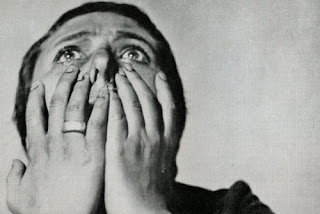Wednesday, February 22, 2012
Wednesday, February 15, 2012
Church of the Holy Close Up
Recently I spoke (typed) a bit about War Horse, and it led me to a thought about visual currents in Hollywood cinema. That being that for all the rumblings claiming film as a "visual medium," many filmmakers, amateur and professional seem to have a startling lack of faith in their images.
Many of the images in War Horse could be considered quite stirring once separated from the image stream. With all that money devoted to nothing other than a chance at effecting you on an emotional level, it's bound to work at least half the time. The other half is layered with an insulting "musical score as emotional guideline" that serves as nothing more than clarifying the clear. The score squanders any good will the images earn by over defining them. Had they been silent the images would have opened themselves to multiplicity, due to their ambiguity of emotion an intent.
Many of the images in War Horse could be considered quite stirring once separated from the image stream. With all that money devoted to nothing other than a chance at effecting you on an emotional level, it's bound to work at least half the time. The other half is layered with an insulting "musical score as emotional guideline" that serves as nothing more than clarifying the clear. The score squanders any good will the images earn by over defining them. Had they been silent the images would have opened themselves to multiplicity, due to their ambiguity of emotion an intent.
In place of aesthetic evolution, is 3-D.
Sunday, February 12, 2012
Images of Horses in Film
War Horse is an emotional epic directed by "the only filmmaker that most Americans can name off the top of their heads."
There are, generally speaking, three types of war films:
1. Films made by those who fought in a war first hand
2. Films made by those who were raised by family members with first hand experience
3. Films made by those who experienced war through war films
Steven Spielberg, philosophically, falls into the third category. His treatment of war is time and time again, both humanistic and morally centered. It represents the type of fighting and dying we want to believe exists in the physical world. The result is a clean (even when filthy), cinematic, battle between sound and image with human characters trapped somewhere in the middle. His camera, being decidedly dramatic (in the Bordwell sense), is capable of achieving any angle imaginable without regard for physical space or character perspective. Thus it's easy to infer that Spielberg's interests are not with the moral ambiguity of killing for ones ideals, but more with the mise en scene of battle. War for Spielberg works as a backdrop, and one that does most of the emotional legwork for the filmmaker, as an audience member will inherently bring with them one (or perhaps all) of the three perceptions of war.
The film looks and sounds like an important cultural artifact, and so, coupled with its pedigree most people (seemingly the Academy included) will treat it as such. They know what to feel before the lights even dim; they are simply waiting for proper cues. And in terms of utilizing cinematic discourse as a cue for emotion, in lieu of any actual emotion War Horse succeeds. In short: Spielberg knows how movies are made, and as such War Horse is the cinematic equivalent of putting together a puzzel of a flower, rather than growing one yourself. At its core, War Horse is a "film as John Ford workshop" for Spielberg, but what he has neglected to include is the emotional build that motivated Ford's aesthetics.
What is interesting about the film is that it operates around a character (Joey...a horse) without a sense of ethics. Joey simply moves through spaces, occasionally stopping to stare blankly back at the ancillary characters that are constantly risking their lives for him. Joey is the reason for the narrative, but never its cause. In a sense he is utilized in the same manner that early Hong Kong films were accused of utilizing female characters. He is a pretty thing meant to stand, back lit by a blood red sunset, while he is photographed from the most pleasing angle possible until he is to be placed in danger.
Monday, February 6, 2012
Letter to the Microcosm
Super8/16mm film has been co-opted by the DSLR reactionalists, and now what we are beginning to realize, much as we did when High Definition became second nature, is that a film cannot impress us simply because it was shot onto celluloid. It has to have some depth and sincerity. I believe we are reaching the high water mark of surface reaction to these new/old aesthetics, and I hope that instead of searching for a new surface, we begin to think introspectively and let what we find inform our choices. For too long we have been doing to opposite.
-Daniel Watkins
-Daniel Watkins
Subscribe to:
Posts (Atom)


